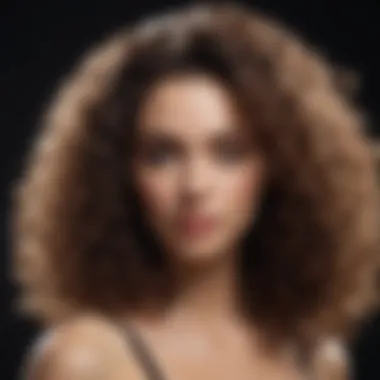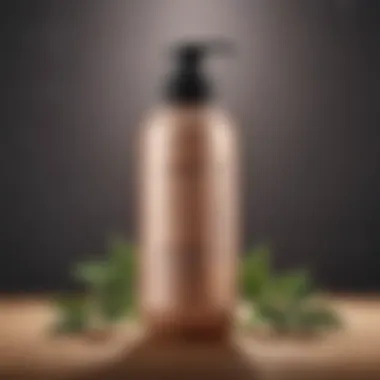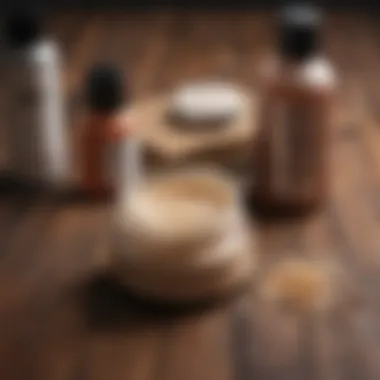Mastering Leave-In Conditioner for 3B Hair


Intro
Understanding hair care for different hair types is crucial for achieving healthy locks. For those with 3B hair, which features tight curls that often have a lot of body and volume, the right products can make a significant difference. One essential product in this regard is leave-in conditioner. It is not just an extra step in a hair care routine, but a vital element that provides moisture, aids in styling, and protects hair from damage.
This article seeks to clarify the specifics about using leave-in conditioner for 3B hair. We will examine the characteristics of 3B hair, discuss how leave-in conditioners function, highlight best application practices, and explore recommended products. We will also delve into the ingredients that can enhance the efficacy of these conditioners and provide methods to optimize their benefits. By the end, readers will have a holistic understanding of the role that leave-in conditioner plays in maintaining the beauty and health of their curls.
Characteristics of 3B Hair
Understanding the characteristics of 3B hair is essential for anyone looking to optimize their hair care routine, especially when it comes to using leave-in conditioners. This hair type is notable for its curls, which tend to be well-defined and springy. The unique features of 3B hair can impact how products are absorbed and the overall effectiveness of hair care rituals.
Texture and Structure
3B hair is characterized by its medium to coarse texture. The curls are tighter than 3A curls, creating a voluminous appearance. The structure consists of individual strands that can vary in thickness. It often feels elastic, and the curls can bounce back into shape after being stretched. This resilience makes it quite versatile but also susceptible to dryness. Understanding these attributes helps individuals select the right leave-in conditioners that cater to moisture needs without weighing the hair down.
Common Challenges
Despite its beauty, 3B hair comes with several challenges. One issue is frizz, which is often exacerbated by humidity. The curly nature can also lead to tangled knots, especially if proper care is not applied. Many who have 3B hair struggle with maintaining moisture levels. Their hair can dry out quickly, leading to breakage and dullness. Recognizing these common challenges is crucial when considering leave-in conditioners, as they can help manage frizz and enhance hydration.
Hair Porosity
Porosity is a key factor that affects how 3B hair interacts with products. There are three levels of porosity: low, medium, and high. Individuals with 3B hair often find that they have medium to high porosity. This means their hair can absorb moisture quickly but may struggle to retain it. Recognizing porosity is important, as it informs the selection of leave-in conditioners with specific ingredients that help seal in moisture effectively. Understanding one's porosity can greatly improve overall hair health and product efficacy.
"Understanding the characteristics of your hair type is the first step toward effective care. With 3B hair, knowing its unique needs can make all the difference in maintaining healthy, beautiful curls."
The Role of Leave-In Conditioner
Leave-in conditioner plays a vital role in the hair care regimen for individuals with 3B hair. Unlike traditional conditioners, which are rinsed out, leave-in conditioners are designed to stay in the hair. This helps to provide continuous moisture and nourishment throughout the day, making them particularly beneficial for the unique characteristics of 3B hair. This hair type, known for its tight curls and volumous structure, often craves additional hydration. Thus, using leave-in conditioners can help mitigate common issues such as dryness and frizz.
What is Leave-In Conditioner?
Leave-in conditioner is a type of hair care product that remains in the hair after washing. These products typically have a lighter formulation compared to rinse-out conditioners, allowing them to be absorbed quickly without weighing the hair down. The primary purpose is to provide hydration, detangling, and protection from environmental factors.
Constituents of leave-in conditioners often include oils, proteins, and humectants, all designed to improve the overall health and appearance of hair. For individuals with 3B hair, using a leave-in conditioner can enhance curl definition and manageability, especially after cleansing.
Benefits for 3B Hair
Leave-in conditioners offer several notable benefits specifically for 3B hair, including:
- Moisture Retention: 3B hair tends to be drier due to its twisty structure. Leave-in conditioners help in keeping hair hydrated over longer periods.
- Frizz Control: The formulation of these products provides a barrier against humidity and helps to smooth the hair cuticle, reducing frizz.
- Enhanced Curl Definition: Regular use of leave-in conditioners can enhance the definition of curls, making them look bouncier and more uniform.
- Detangling Properties: They can ease the process of detangling, preventing breakage and facilitating easier comb-through.
- Heat Protection: Some leave-in conditioners also offer protection against heat damage from styling tools, which can be crucial for maintaining hair integrity.
Key Ingredients to Look For
When selecting a leave-in conditioner for 3B hair, consideration of its ingredients is very important. Here are some key components that should be present:


- Aloe Vera: Known for its moisturizing properties, aloe vera helps in hydration and promotes softness.
- Glycerin: This humectant draws moisture into the hair, ensuring that curls remain hydrated and plump.
- Shea Butter: Provides deep nourishment and helps to seal moisture, crucial for maintaining curl definition and reducing frizz.
- Coconut Oil: Known for its penetrating properties, it helps reduce protein loss while adding shine.
- Hydrolyzed Proteins: Such as silk or keratin, these ingredients can help strengthen hair and improve elasticity.
A well-formulated leave-in conditioner can greatly improve the manageability and appearance of 3B hair by providing essential hydration and protection.
Application Techniques
Understanding the proper application techniques for leave-in conditioner is crucial for individuals with 3B hair. This hair type, characterized by its wiry, springy curls, benefits significantly from tailored hair care methods. Effective application can enhance moisture retention, reduce frizz, and promote overall hair health. This section will discuss the fundamental steps to prepare your hair, the recommended methods for applying leave-in conditioner, and the best practices to follow post-application.
Preparation Steps
Before applying leave-in conditioner, it is essential to prepare your hair adequately. Start with clean, damp hair. Washing your hair with a sulfate-free shampoo is advisable. Sulfates can strip natural oils, leading to dryness. After shampooing, follow up with a nourishing conditioner, focusing on the lengths and ends of your hair.
After rinsing out the conditioner, gently squeeze excess water from your hair using a microfiber towel or an old cotton t-shirt. The goal is to keep the hair damp, not soaking wet, as this helps the leave-in conditioner to absorb effectively. Remember, 3B hair tends to dry out quickly, so timing is key to maximize moisture absorption.
How to Apply Leave-In Conditioner
When applying leave-in conditioner, consider the following steps for optimal results:
- Divide Your Hair: Split your hair into sections. This allows for a more even application and ensures that each strand gets sufficient product.
- Use the Right Amount: Start with a small amount of leave-in conditioner. For most people with 3B hair, a quarter-sized amount works well for each section. You can always add more if necessary.
- Distribute Evenly: Rub the product between your palms and then apply it to your hair. Focus on the mid-lengths and ends, where moisture is most needed. Use a wide-tooth comb or your fingers to comb through the sections, ensuring even distribution.
- Scrunch for Definition: Use a scrunching motion to help define the curls. This method encourages curl formation and gives hair a more natural look.
Applying leave-in conditioner immediately after your shower, while your hair is still damp, creates an environment for enhanced moisture retention. This is particularly important for 3B hair, as it helps combat dryness.
Best Practices Post-Application
After applying leave-in conditioner, there are several best practices to keep in mind to ensure your hair remains healthy and nourished:
- Avoid Over-Manipulation: Once you’ve applied the product, minimize touching and styling your hair. Over-manipulation can lead to frizz and breakage.
- Let Hair Air-Dry: If possible, let your hair air-dry to maintain its natural texture and health. If you need to use a heat source, use a diffuser attachment on a low heat setting to avoid heat damage.
- Regularly Reseal Moisture: Every few days, reapply a small amount of leave-in conditioner to refresh your curls. This helps in maintaining hydration in between washes.
"Proper application techniques play a vital role in unlocking the benefits of leave-in conditioners, allowing individuals with 3B hair to embrace their unique texture every day."
Utilizing effective application techniques ensures that your leave-in conditioner performs at its best, creating a solid foundation for the health of your 3B hair.
Selecting the Right Product
Selecting the right product for your hair is crucial, especially for those with 3B hair. This hair type is known for its defined curls that can vary in tightness and density. For effective management, leave-in conditioners must cater to the unique needs of 3B hair.
When considering a leave-in conditioner, it is important to focus on several key elements:
- Ingredients: The formulation of the leave-in conditioner plays a pivotal role in delivering moisture and enhancing curl definition. Look for products rich in natural oils such as argan oil or jojoba oil, as well as shea butter, which can help to provide deep hydration.
- Weight: The weight of the product is essential. A lightweight leave-in conditioner may be better for those looking for volume, while thicker formulations can provide extra moisture and hold for defined curls.
- Absorption: Consider how quickly the product absorbs into the hair. A good leave-in should not leave a greasy residue. It should feel light and allow curls to feel soft and bouncy.
Selecting the right product not only maintains your hair’s health but also enhances the overall appearance of your curls.
"Using the right leave-in conditioner can transform your 3B hair from frizz to fabulous. It is not just about moisture, but also about defining curls effectively."
Top Industry Recommendations


There are many leave-in conditioners specifically crafted to address the needs of 3B hair. Professionals and enthusiasts alike often recommend the following products:
- Kinky Curly Knot Today: Known for its restorative properties, this product works well in detangling while providing moisture.
- Ouidad Moisture Lock Leave-In Conditioner: This conditioner helps to maintain curls and prevent frizz, making it a popular choice among curly hair users.
- SheaMoisture Jamaican Black Castor Oil Leave-In Conditioner: Ideal for those seeking to strengthen and nourish their curls, this is touted for its beneficial ingredients.
When choosing a leave-in conditioner, always consider your hair's specific needs to achieve the best results.
DIY Leave-In Conditioners
Some individuals prefer to create their own leave-in conditioners at home. This approach can be cost-effective and allows for tailored solutions. Here are a few simple recipes:
- Coconut Oil Leave-In: Mix one part coconut oil with five parts water in a spray bottle. Shake well before each use. This mixture provides lightweight moisture and shine.
- Aloe Vera Leave-In: Combine one cup of aloe vera gel with a few drops of essential oil for added fragrance. This not only hydrates but also helps to define curls effectively.
- Honey and Water Mixture: Mix one tablespoon of honey with one cup of water as a natural moisturizer. Honey attracts moisture making it ideal for dry hair.
Using DIY solutions enables you to control the ingredients and optimize the results for your 3B hair type.
Effects of Environmental Factors
Understanding how environmental factors affect 3B hair is crucial for maintaining its health and appearance. The unique structure of 3B hair makes it particularly susceptible to changes in humidity and temperature. Both external conditions influence how hair retains moisture and how products, such as leave-in conditioners, perform.
Humidity Considerations
Humidity poses a significant challenge for 3B hair. High humidity levels can lead to increased frizz and loss of definition in curls. When the air is moist, hair tends to absorb water, which can cause the cuticle to swell. This results in curls losing their shape and becoming unpredictable.
Strategies to Manage Humidity:
- Choose a leave-in conditioner that provides a strong hold without weighing down the hair.
- Incorporate anti-frizz serums before applying leave-in conditioners to create a barrier against moisture.
- Avoid heavy products that can exacerbate puffiness.
It is important to apply products when the hair is damp but not wet. This ensures that the hair can effectively lock in the moisture without absorbing excess water from the atmosphere.
Seasonal Changes
Seasonal variations also affect 3B hair. For instance, winter often leads to drier air, which can strip hair of natural oils. Conversely, summer generally brings more humidity but can also lead to sun damage.
To adapt to different seasons, adjust your hair care routine accordingly:
- In winter, focus on moisture-rich leave-in conditioners that help to combat dryness. Look for ingredients like shea butter and oils.
- In summer, consider lightweight leave-ins that protect hair from UV rays. Products that contain antioxidants can be beneficial.
Each season entails different challenges. Monitoring these changes and adjusting products can keep 3B hair nourished and manageable year-round.
"Adapting hair care products with the seasons is key to maintaining healthy hair."
The interplay between these environmental factors and 3B hair highlights the importance of a tailored routine. By being mindful of humidity and seasonal impacts, those with 3B hair can maximize the effectiveness of their leave-in conditioners and maintain vibrant curls.
Common Misconceptions
Understanding the common misconceptions surrounding leave-in conditioners is crucial for effectively caring for 3B hair. Many individuals hold erroneous beliefs about hair products that may hinder their ability to achieve healthy and moisturized hair. Addressing these misconceptions helps to demystify the role of leave-in conditioners and provides clarity on their benefits.


Leave-In Conditioners vs Rinse-Out Conditioners
A prevalent misunderstanding relates to the difference between leave-in conditioners and rinse-out variants. Rinse-out conditioners are usually applied post-wash and then thoroughly rinsed off. They serve to provide immediate moisture and detangling, yet their effects are temporary and may not be sufficient for maintaining the curls of 3B hair.
In contrast, leave-in conditioners are formulated to be left in the hair, providing continuous hydration throughout the day. They work to retain moisture and protect hair from environmental factors, making them essential for individuals with textured hair. By providing a lasting layer of nourishment, leave-in conditioners help to combat frizz and enhance styling. Misunderstanding these roles can lead to improper product choice, leaving the hair feeling dry and unmanageable.
Myths About Hair Products
Several myths about hair products persist in popular culture. For example, one common myth is that all hair products containing silicones are detrimental to hair health. While some silicones can lead to buildup, many are safe and can enhance shine and manageability. Select silicones, like dimethicone, provide an effective barrier against humidity, which is particularly advantageous for 3B hair in humid conditions.
Another misconception is that natural or organic products are always better. While these products can certainly offer benefits, it is important to remember that not all natural ingredients are suitable for every hair type. For 3B hair, finding the right balance of ingredients is essential, whether natural or synthetic. Understanding the truth behind these myths is vital for making informed decisions about hair care products and achieving optimal results.
"The best way to care for your hair is to understand what it needs and not just follow trends or hearsay."
Long-Term Care Strategies
Effective long-term care strategies are fundamental for maintaining the health and beauty of 3B hair. Understanding how to incorporate leave-in conditioners into a daily routine plays a significant role in achieving moisture balance and preventing damage. With 3B hair being prone to frizz and dryness, establishing a reliable regimen can lead to improved hair texture and resilience over time.
By focusing on long-term strategies, individuals can create a sustainable approach to hair care that meets their unique needs. These strategies encompass product selection, consistent application methods, and a keen observation of changing hair conditions. Integrating these practices not only enhances the aesthetic appeal of the hair but also fosters overall hair health long term.
Routine Maintenance Tips
Routine maintenance is key in the care of 3B hair. It is essential to incorporate certain uncomplicated practices that can make a significant difference. Here are several tips to consider:
- Weekly Deep Conditioning: A deeper treatment helps restore moisture and nutrients. Use a deep conditioner formulated specifically for curly hair at least once a week.
- Regular Trims: Cutting split ends every six to eight weeks can prevent further damage and promote healthier hair growth.
- Hydration: Drink plenty of water daily. Hydrated bodies contribute to healthier hair.
- Protective Styles: Consider wearing styles that protect the hair from environmental stressors. Braids or buns can shield the strands especially during harsh weather.
- Night Care: Use silk or satin pillowcases to reduce moisture loss and friction while sleeping. Alternatively, a silk scarf can protect the hair overnight.
Implementing these tips will create a foundation for healthier hair and ensure that moisture is locked in, catering to the specific needs of 3B hair.
When to Reevaluate Products
Hair care is not a one-size-fits-all approach. The dynamic nature of hair means product effectiveness can change due to several factors. Here are some signs it’s time to reevaluate your hair products:
- Change in Hair Texture: If the feel of the hair becomes different or less manageable, a shift in products may be necessary.
- Increased Frizz: If frizz levels rise despite regular conditioning, it indicates that the product may not provide adequate moisture anymore.
- Product Buildup: If hair appears dull and lifeless, it may be a sign of product residue. Switching to clarifying products can help remove buildup.
- Seasonal Changes: Different seasons demand different product needs. As humidity and temperature fluctuate, the right products must adapt to these changes.
- Health Changes: Hormonal changes or stress can impact hair condition. Regularly assess products to ensure they still meet your needs.
By monitoring these factors, you can make timely adjustments to your hair care routine, ensuring your leave-in conditioner remains effective in maintaining the vibrancy and health of 3B hair.
"Adopting the right long-term care strategies is essential for the health of 3B hair, allowing it to thrive under varying conditions."
Each of these elements contributes to creating a personalized hair care journey, cultivating a deeper understanding of how leave-in conditioner can significantly enhance overall hair health in the long run.
Epilogue
In the context of hair care for individuals with 3B hair, understanding the role of leave-in conditioner is paramount. The conclusion serves to encapsulate the fundamental insights shared throughout the article. This section highlights effective strategies, dispels myths, and emphasizes the significance of tailored products for maintaining healthy and vibrant curls.
Key elements covered in this article include:
- Characteristics of 3B hair: Understanding the texture, common challenges, and porosity is crucial for selecting the right products.
- Benefits of leave-in conditioners: These products provide critical moisture, manage frizz, and enhance the overall appearance of curls.
- Application techniques: Knowing how to properly apply leave-in conditioner ensures maximum efficacy, allowing individuals to achieve desired results without excessive buildup.
- Selection of products: The article dissects the various options, encouraging readers to consider both established brands and DIY alternatives that cater specifically to their needs.
- Addressing environmental factors: Being aware of humidity and seasonal changes can inform product usage and care routines.
- Long-term care strategies: Routine maintenance and product reevaluation are necessary for ongoing hair health.
Summarizing Key Takeaways:
Leave-in conditioner is not just a styling aid; it is integral to the hair care regimen for 3B hair types. The right leave-in conditioner can transform dry, frizzy curls into well-defined, moisturized locks. Throughout this article, the importance of understanding hair type, ingredient knowledge, and proper application methods has been stressed to empower individuals to make informed choices. These practices yield long-term benefits, fostering a more nuanced understanding of hair care, leading to healthier hair overall.
By synthesizing the insights shared above, readers become equipped with the knowledge needed to navigate their hair care journey effectively, appreciating the unique demands of their 3B curls.



